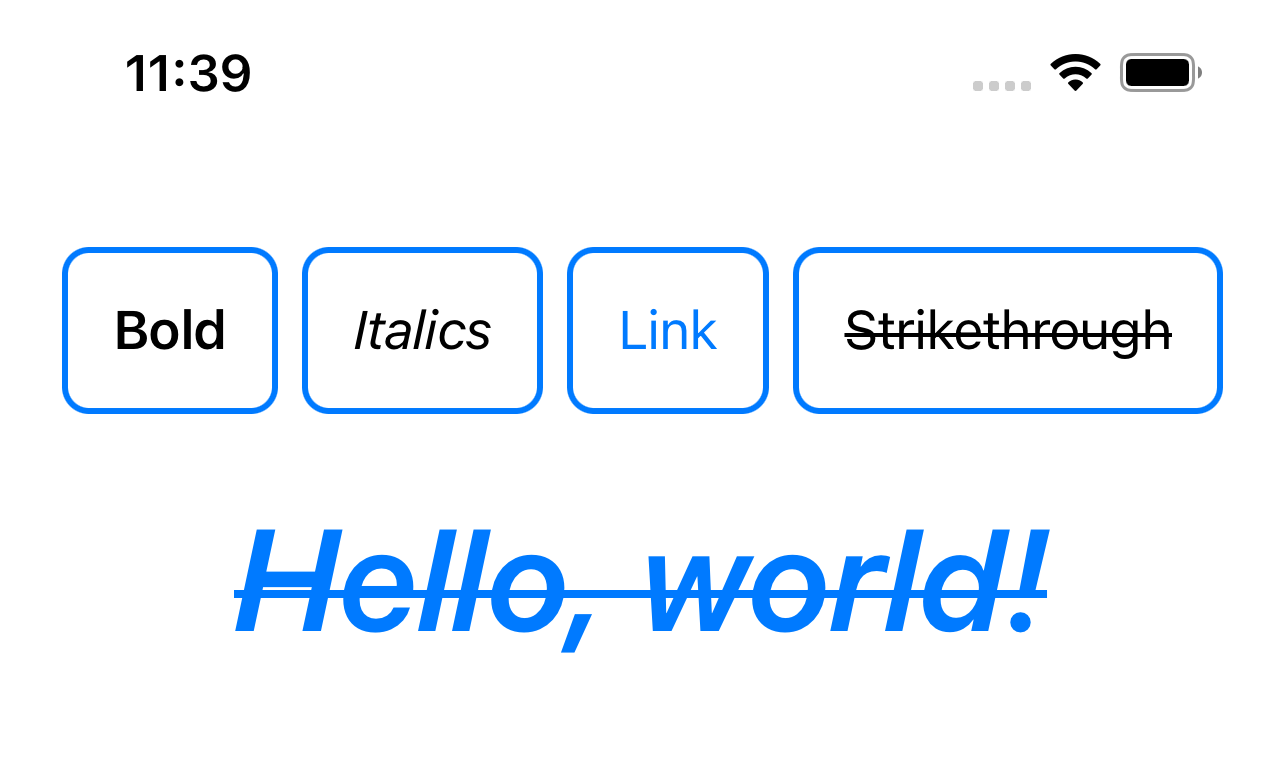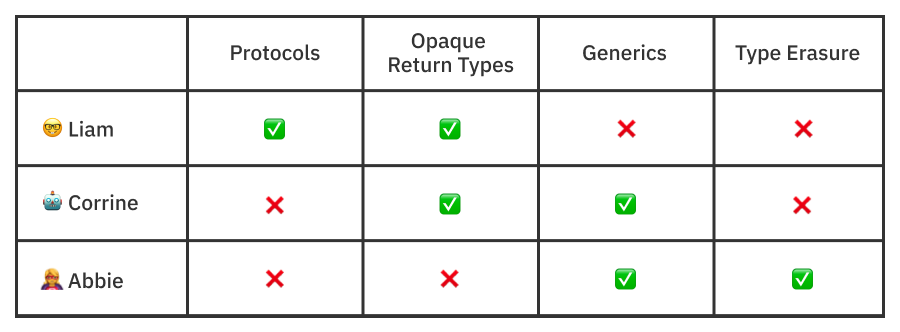本系列文章将从实践技巧、实现原理以及追踪语言更新等方面对 Swift Protocol 展开深入讨论。主要内容有:
Swift Protocol 背后的故事(实践)
Swift Protocol 背后的故事(理论)
Swift Protocol 背后的故事(Swift 5.6/5.7)
…
本文是系列文章第一篇,主要介绍实践技巧,以一个 Protocol 相关的编译错误为引,通过实例对 Type Erasure、Opaque Types 、Generics 以及 Phantom Types 做了较详细的讨论。它们对于写出更优、更雅的 Swift 代码有一定的帮助。
©原创文章,转载请注明出处!
引
Swift 推崇面向协议编程 (POP, Protocol Oriented Programming),因此 Protocol 在 Swift 中就显得尤为重要。
但本文要讨论的既不是 Protocol 的使用,也不是 POP。
我们的讨论从一个编译错误开始:
Protocol ‘Equatable’ can only be used as a generic constraint because it has Self or associated type requirements.
2022 年 06 月 30 日更新:从 Swift 5.7 起不再会有这个错误了,详情请见 Swift Protocol 背后的故事(Swift 5.6/5.7)。
对于 Swift 开发者来说上面这个编译错误应该不陌生。
其字面意思不难理解:含有 Self 或关联类型的协议只能用作泛型约束,不能单独作为类型使用。
Why?
因为 Swift 是类型安全的语言 (type-safe language)。
why?
上面这个解释是句『 正确的废话 』,没有说到点子上。
下面我们以一个 Demo 为基础展开今天的讨论 (GitHub - zxfcumtcs/MarkdownDemo: Swift Protocol Demo):
如上图,MarkdownEditor 是一个 Markdown 格式的编辑器。
为了处理不同的 Markdown 格式,我们定义了协议 MarkdownBuilder, 其作为公开接口曝露给业务方:
1 | public protocol MarkdownBuilder: Equatable, Identifiable { |
由于有判等需求,
MarkdownBuilder继承了Equatable协议。
如果我们直接将 MarkdownBuilder 作为类型使用,如:var builder: MarkdownBuilder ,就会报上面的错误。
因为,Equatable 有 Self requirements:要求 == 操作符的两个参数 lhs 与 rhs 的类型必须相同 (注意是准确的类型,而不是说只要遵守 Equatable 即可)。
1 | public protocol Equatable { |
假如,允许有 Self requirements / Associated Type 的 Protocol 作为类型使用,就会出现以下情况,而编译器却无能为力:
1 | let lhs: Equatable = 1 // Int |
对于 Associated Type 也是同样的道理:
1 | // 用于校验电话号码是否合法 |
说这么多,归根结底是因为 Protocol 是运行时特性,而其附带的 Self requirements / Associated Type 却需要在编译时保证。其结果必定凉凉~
Generics 是编译期特性,在编译时就能明确泛型的具体类型,故有
Self requirements/Associated Type的 Protocol 只能作为其约束使用。
Type Erasure
回到上节提到的 Markdown 编辑器:MarkdownEditor,我们实现了4种格式的 MarkdownBuilder:
1 | extension MarkdownBuilder { |
struct MarkdownView: View是整个 Demo 的主界面,需要在其中存储所有支持的 Markdown Builder,以及当前选中的 Builder。
所以,我们不加思索地写下了以下代码:
1 | struct MarkdownView: View { |
结果可想而知!
怎么办?
Generics? 在这里似乎行不通!
将所有支持的 Builder 逐个定义出来?
太蠢了!且不符合『 OCP 』原则。
此时,就需要用到本节的主角:Type Erasure (类型擦除)。
Type Erasure 是一项通用技术,并非 Swift 特有,核心思想是在编译期擦除 (转换) 原有类型,使其对业务方不可见。
有多种方式可以实现 Type Erasure,如:Boxing、Closures 等。
在 MarkdownEditor 中,我们通过 Boxing 实现 Type Erasure,简单讲就是对原有类型做一次封装 (Wrapper):
1 | public struct AnyBuilder: MarkdownBuilder { |
几个关键点:
AnyBuilder实现了MarkdownBuilder协议,(一般情况下 Wrapper 都需要实现待封装的协议);- 其
init是泛型方法,并将参数传递过来的style、build(from:)存储下来; - 在其自身的
build(from:)方法中直接调用存储的wrappedApply,其本身相当于一个转发代理。
同时,扩展 MarkdownBulider:
1 | public extension MarkdownBuilder { |
现在,我们就可以愉快地在 MarkdownView 中使用 AnyBuilder 了:
1 | struct MarkdownView: View { |
由于有上面的 MarkdownBuilder 扩展,可以通过 2 种方式生成 AnyBuilder 实例:
BoldBuilder().asAnyBuilder()AnyBuilder(BoldBuilder())
在 Swift 标准库中有大量通过 Boxing 实现的 Type Erasure ,如:
AnySequence、AnyHashable、AnyCancellable等等。以 Any 为前缀的几乎都是。
Opaque Types
如果,我们准备将 MarkdownEditor 做成一个独立的三方库,并且除了 MarkdownBuilder 协议,不打算曝露任何其他的实现细节以增加其灵活性。
即,ItalicsBuilder、BoldBuilder、StrikethroughBuilder 以及 LinkBuilder 都是库私有的。
如何做?
又一次不加思索地写下了以下代码:
1 | public func italicsBuilder() -> MarkdownBuilder { |
我们希望通过 public func 为业务方创建相应的 Builder 实例,同时以接口的方式返回。
理想丰满,现实骨感!
同样的错误在等着你!
怎么办?
轮到本节主角 Opaque Types 登场了!
简单讲,Opaque Types 就是让函数/方法的返回值是协议,而不是具体的类型。
A function or method with an opaque return type hides its return value’s type information.
Instead of providing a concrete type as the function’s return type, the return value is described in terms of the protocols it supports.
几个关键点:
关键字
some,需在返回协议类型前添加some关键词,如:public func regularBuilder() -> some MarkdownBuilder
而不是public func regularBuilder() -> MarkdownBuilderOpaque Types 与直接返回协议类型的最大区别是:
Opaque Types 只是对使用方(人)隐藏了具体类型细节,编译器是知道具体类型的;
而直接返回协议类型,则是运行时行为,编译器是无法知道的;
如下代码,编译器是明确知道
italicsBuilder方法的返回值类型是ItalicsBuilder,但方法调用方却只知道返回值遵守了MarkdownBuilder协议。从而也就达到了隐藏实现细节的目的;1
2
3public func italicsBuilder() -> some MarkdownBuilder {
ItalicsBuilder()
}正是由于编译器需要明确确定 Opaque Types 背后的真实类型,故不能在 Opaque Types 方法中返回不同的类型值,如下面这样是不允许的 (Opaque Types 属于编译期特性):
1
2
3
4
5
6
7
8public func italicsBuilder() -> some MarkdownBuilder {
if ... {
return ItalicsBuilder()
}
else {
return BoldBuilder()
}
}
好了,现在我们知道只需在上述不加思索写出的代码中加入 some 关键字即可,不再赘述。
在 SwiftUI 中,大量使用到 Opaque Types。甚至可以说 Opaque Types 是为 SwiftUI 而生的。
Phantom Types
Phantom Types 本身与本文讨论的内容相关性不大,作为相似的概念,我们简单介绍一下。
Phantom Types 也非 Swift 特有的,属于一种通用编码技巧。
Phantom Types 没有严格的定义,一般表述是:出现在泛型参数中,但没有被真正使用。
如下代码中的 Role (例子来自 How to use phantom types in Swift),它只出现在泛型参数中,在 Employee 实现中并未使用:
1 | struct Employee<Role>: Equatable { |
What?
Phantom Types 有何用?
用于对类型做进一步的强化。
Employee 可能有不同的角色,如:Sales、Programmer 等,我们将其定义为空 enum:
1 | enum Sales { } |
由于 Employee 实现了 Equatable,可以在两个实例间进行判等操作。
但判等操作明显只有在同一种角色间进行才有意义:
1 | let john = Employee<Sales>.init(name: "John") |
正是由于 Phantom Types 在起作用,上述代码中的判等操作编译无法通过:
Cannot convert value of type ‘Employee
将 Phantom Types 定义成空 enum,使其无法被实例化,从而真正满足 Phantom Types 语义。
由于 Swift 没有 NameSpacing 这样的关键字,故通常用空 enum 来实现类似的效果,如 Apple Combine Framework 中的
Publishers:
然后在 extension 中添加具体 Publisher 类型的定义,如:
2
3
4
5
struct First<Upstream>: Publisher where Upstream: Publisher {
...
}
}
从而,可以通过
Publishers.First的方式引用具体的 Publisher。关于适当使用命名空间的好处在:Five powerful, yet lesser-known ways to use Swift enums 中有一段精彩描述:
Using the above kind of namespacing can be a great way to add clear semantics to a group of types without having to manually attach a given prefix or suffix to each type’s name.
So while the above
Firsttype could instead have been namedFirstPublisherand placed within the global scope, the current implementation makes it publicly available asPublishers.First— which both reads really nicely, and also gives us a hint thatFirstis just one of many publishers available within thePublishersnamespace.It also lets us type
Publishers.within Xcode to see a list of all available publisher variations as autocomplete suggestions.
小结
Swift 作为 POP (Protocol Oriented Programming) 的提倡者,Protocol 的地位自然十分重要,Swift 赋于其强大能力。
同时,Swift 又是类型安全的,因此对于带有 Self requirements / Associated Type 的 Protocol 在使用上又有一定的限制。
结合实例,本文主要介绍了如何通过 Type Erasure、Opaque Types 以及 Generics 等方式解决上述限制。
在 Opaque Return Types and Type Erasure 这篇文章中作者分别从库的开发者 (Liam)、编译器 (Corrine)、使用方 (Abbie) 的视角分析了他们是否了解 Protocols、Opaque Types、Generics 以及 Type Erasure 背后的私密:

如上图:
Protocols:
- 协议本身具有隐藏实现细节以及运行时实例化的特性,故编译器、使用方无法知道其背后对应的真实类型;
- 但,作为库的开发者 (代码是他写的),明确知道 Protocol 背后可能对应的所有真实类型。
Opaque Types:
- 同 Protocols,库的开发者肯定是知道的;
- 由于 Opaque Types 限制只能对应一种真实类型,并在编译期需明确,故编译器是知道的;
- 对于使用方来说,他们看到的还是隐藏了细节的 Protocol。
Generics:
- 泛型是将类型决定权让给使用方的,故库的开发者是不知道真实类型的,而使用方知道;
- 泛型属于编译期行为,故编译器能明确知道泛型对于的真实类型。
Type Erasure:
- 类型擦除属于使用方行为,用于规避编译错误等,故只有使用方知道。
参考资料
swift-evolution · Opaque Result Types
Different flavors of type erasure in Swift
Opaque Return Types and Type Erasure
How to use phantom types in Swift
swift/TypeMetadata.rst at main · apple/swift · GitHub
swift/TypeLayout.rst at main · apple/swift · GitHub